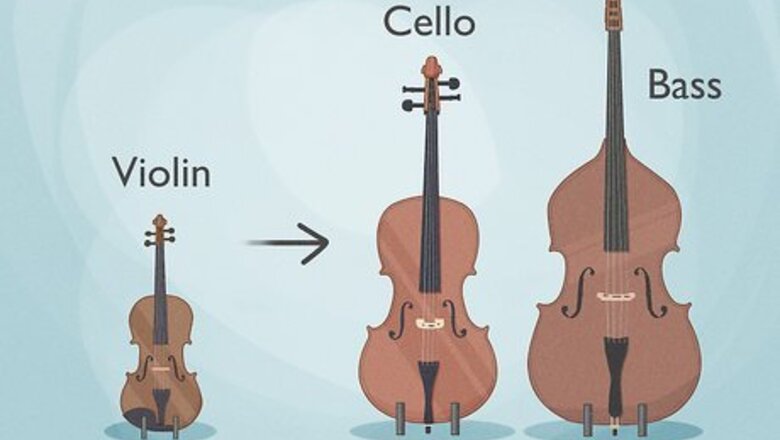
views
- Cellos and basses are members of the violin family, which also includes the viola and violin.
- Cellos have a tenor range (C2 - A5), while basses have a lower “bass” range (E1 - G4). Cellos are tuned in fifths, while basses are tuned in fourths.
- Basses are larger and heavier than cellos. Bass players usually have to stand while playing to reach all the notes, but cellists can easily play seated.
- Cellos play a wider variety of roles in music than basses. You’ll often hear cellos playing solos and melodies, while basses are usually in the background.
Cellos and basses are members of the violin family.
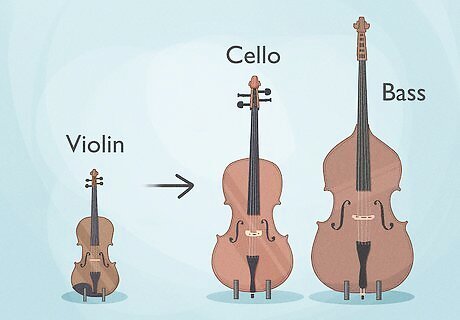
Both are built like violins and violas, and are played similarly. Cellos and basses feature a neck, hollow body, and four strings supported by a bridge. To choose notes, players press the strings against the fingerboard—the dark strip of wood that sits on the neck. They then pluck, strum, or bow the strings with the right hand, producing sounds that get amplified by the wooden body. Both instruments are known by other names. Cellos are also called violoncellos, while the bass is sometimes referred to as the double bass, bass viol, or contrabass. The bass guitar, which is also referred to as a bass, is a different instrument than the kind used in orchestras.
Cellos and basses have different ranges.
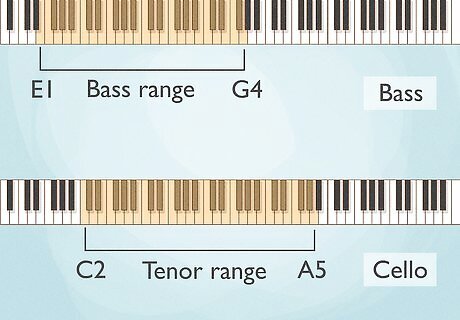
The cello has a tenor range, while the bass has a lower “bass” range. Specifically, cellos can play notes from C2 - A5, giving them a range of just under five octaves. The bass can play notes from E1 - G4, which gives it a range of just over 3 octaves. For context, a tenor range is roughly equivalent to Freddie Mercury’s singing voice. Barry White, the R&B musician famous for his deep voice, sang in a bass range. Cellos, basses, and other stringed instruments can extend their ranges using harmonics. This technique involves lightly touching a string (but not pressing it) and plucking or bowing it, creating a higher-pitched that has a distinct tone.
Basses and cellos are different sizes.
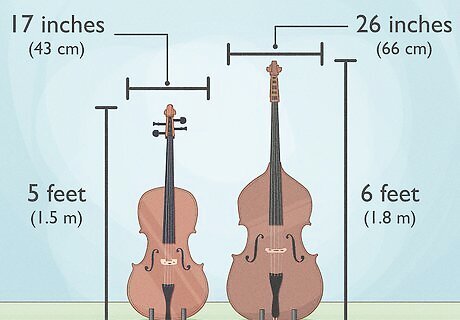
Basses are much larger and heavier than cellos. A full-size bass is roughly 6 feet (1.8 meters) tall and spans 26 inches (66 cm) at its widest point. They can be as heavy as 25 lbs (11 kg). A full-size cello, on the other hand, is only 5 feet (1.5 m) tall and 17 inches (43 cm) at its widest point. Most cellos weigh less than 8 lbs (3.6 kg). To protect their instruments, many musicians transport basses and cellos in large cases. Depending on the make and quality, a cello or bass case can be enormous and weigh 20-40 lbs (9-18 kg) or more—not including the instrument inside.
Cellos are tuned differently than basses.
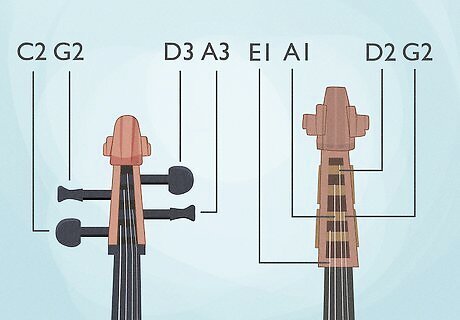
A cello is tuned in fifths, while a bass is tuned in fourths. Specifically, a cello’s four strings are usually tuned to C2, G2, D3, A3, lowest to highest. Each note is separated by a “perfect fifth,” which is equal to seven half-steps. Meanwhile, a bass’ four strings are tuned to E1, A1, D2, G2, lowest to highest. Each note is separated by a “perfect fourth,” which is equal to five half-steps. The different tuning means that musicians have to move their fingers differently to reach specific notes on a bass than they would for those same notes on a cello—and vice versa. A “half-step” is equal to one key on the piano. So for example, the second string on a cello, G2, is seven piano keys higher than the first string, C2.
Cellos play melodies and solos, but basses usually don’t.
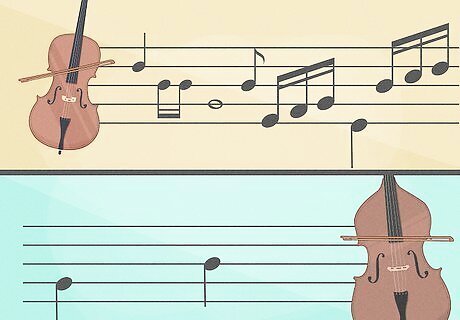
Cellos often play over the bass and dominate the music’s sound. The bass is rarely heard independently from other instruments. Instead, basses usually play low-pitch notes that help define the sound and rhythm of a piece of music. As such, cellos are more often in the musical spotlight than basses. Despite the cello being more audible and prominent, orchestras like the New York Philharmonic still have multiple bassists and cellists on staff. The number of cellos or basses required for a piece of music can vary widely, so cellists and bassists are both valued members of an orchestra. In some modern music, basses (and bass guitars) play a much more prominent role and can be heard soloing or playing melodies. But this is still an exception, and usually, the bass is kept in the background.
Sheet music is written differently for the bass and cello.

The bass is a transposing instrument, while the cello isn’t. For transposing instruments like the bass, what’s written is not what’s played. Instead, bass notes are written one octave higher than normal, and bass players “transpose” the music by playing everything one octave lower. Cello players, on the other hand, play exactly what’s written. The reason for this is that a bass’ range is so low that most of its notes sit far below staff at the bass clef (a.k.a., the swirly symbol on the left side of sheet music that represents low-pitch notes). Since the notes are so low, you’d normally need to add extra lines beneath the staff—the group of lines in front of the bass clef where notes are written. To make things easier, musicians “transpose” the notes by writing everything one octave higher, allowing the notes to fit neatly within the staff in front of the bass clef. Bassists are trained to play everything one octave lower so that it sounds correct.
Cellos are basses are played differently.

A bassist usually stands while playing, while a cellist sits. The bass is so large that a sitting player wouldn’t be able to reach the whole fingerboard. To compensate, a bassist stands next to their instrument to give them better reach. Cellos are smaller, so many cellist play seated, holding the cello in place with their knees. Some bassists play while sitting on tall a stool. This lets them reach the top of the instrument without having to stand.




















Comments
0 comment